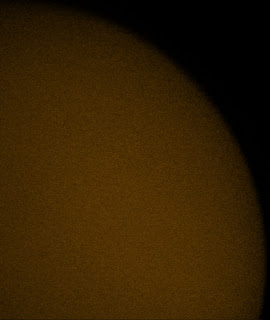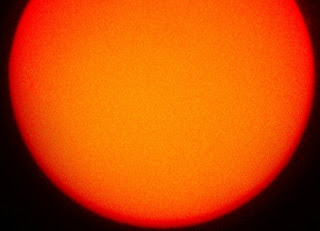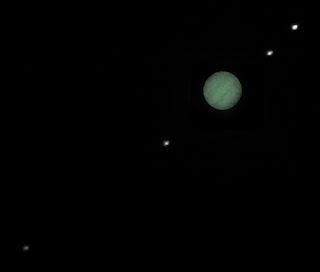February 29th 0900 GMT
I bin scanned the Sun but did not see any sunspots, probably
because the Sun was low down.
February 28th 2100 GMT
A hazy day gave way to a quite decent evening, although
there was still some haze around, especially to the north. I took two sets of
frames, both at ISO 6400. The first was at 70mm and 8 seconds’ exposure and
was aimed at:- Cassiopeia
- Perseus Double Cluster and surrounding area
- Melotte 20 and surrounding area
- Melotte 111
- Darks
- Jupiter with moons
- Beehive (M44)
- Pleiades (M45)
- NGC 1647 near Aldebaran
The second shot was composed of 11 light and 11 dark frames. I was particularly pleased with it.
I found the Melotte 20 shot interesting in widefield, as I usually photograph it at 200mm or 300mm focal length.
OK, confession time! I didn't get Melotte 111 but some area of space nearby. I thought it was worth processing anyway and it showed a close double star to the upper right.
My shots of Jupiter with moons did not stack, so I processed a single image. 3 moons were very close together and one was partially obscured by the planet.
The Beehive (M44) shot was slightly out of focus but looked better when shrunk.
The second shot was composed of 11 light and 11 dark frames. I was particularly pleased with it.
I found the Melotte 20 shot interesting in widefield, as I usually photograph it at 200mm or 300mm focal length.
OK, confession time! I didn't get Melotte 111 but some area of space nearby. I thought it was worth processing anyway and it showed a close double star to the upper right.
My shots of Jupiter with moons did not stack, so I processed a single image. 3 moons were very close together and one was partially obscured by the planet.
The Beehive (M44) shot was slightly out of focus but looked better when shrunk.
I missed NGC 1647 but caught part of the Hyades near Aldebaran.
February 28th 1130 GMT
I had a clearer view when the Sun was above most of the haze
and I could see one large sunspot and two smaller ones nearby. These were new
activity.
February 28th 1050 GMT
February 27th 1050 GMT
I bin scanned the Sun though cloud and did not see any sunspots.
February 24th 1215 GMT
I checked the Sun in hydrogen alpha light with my PST. It
was rather quiet but there was a filament and very small prominence near to
where a sunspot was.
February 24th 0830 GMT
I bin scanned the Sun in hazy conditions and did not see any
sunspots.
February 23rd 2210 GMT
The Moon was just past full and near Jupiter. There was some
haze, so there was only one thing to do! Jupiter was nearby, within 2 degrees
and I was not going to stay up until closest approach just after 3 AM. I took 3
sets of frames using my DSLR starting at ISO 800, 300mm and 1/4000 second
exposure. I did another set at 1/100 second exposure and the final one at 1
second. I tried a frame with 3 seconds’ exposure but found it over-exposed.
The first image was composed of 19 lunar frames that were slightly out of focus.
I stacked 7 frames of the Moon with Jupiter to get this.
I processed 11 frames and 10 darks, of which 9 stacked to get Jupiter with its moons.
... and finally, the three put together for the final result.
February 23rd
I
bin scanned the Sun in an almost clear sky but did not see any sunspots.
February 19th 1150 GMT
As cloud was predicted, I checked the Sun with my PST. The
disc looked bland and featureless, except for the sunspot but I saw some
prominences at about the 10 o’ clock position. I took some full disc shots and close-ups.
I stacked 5 full disc frames but my first attempt to stack resulted in an egg shape. By trial and error, I discovered that the 5th frames was the culprit, so this is a stack of the first four.
February 19th 0845 GMT
As the day before, just a solitary sunspot was on display.
February 18th 1600 GMT
I did a short outreach session at my workplace. It was
daylight but the Moon was high enough for observation. I set my binoculars on a
camera tripod and my colleagues were amazed by the detail they could see on the
Moon. Tycho’s rays and the southern craters were very prominent.
I forgot to bring a camera but, fortunately, Ben Jenkins took an image with his phone camera and I processed it.
February 18th 1250 GMT
I bin scanned the Sun. The sunspot I had seen previously had
rotated off but a new one had emerged.
February 16th 1205 GMT
I checked the Sun with my PST. The main disc was rather
bland and featureless but I saw three small prominence. Early indications
suggested that none was obvious in my photos and I would need to attempt
processing to have any hope of showing them.
One prominence was visible in the third image.
February 15th 1200 GMT
I checked the Sun in hydrogen alpha light with my PST. The disc looked rather bland, except for some detail near the sunspot. I could make out a plage structure and there were two small prominences nearby. I took some full-disc shots and some close-ups of the region of interest.
February 15th 0845 GMT
A solar bin scan revealed a single sunspot about to rotate off.February 14th 1900 GMT
The Moon was about 6 days past new. Owing to disc space, I needed to do two stacking runs before combining the results of both stacks. I took 73 images of the Moon with my Mak and DSLR at ISO 800 and 1/1000 second exposure and stacked all except one.February 14th 1515 GMT
At the third attempt, I saw a sunspot near the solar limb through thin cloud.February 13th
With wall-to-wall cloud, I reprocessed a photo of Jupiter with moons from December 6th 2013.
February 12th 0855 GMT
I bin scanned the Sun. Maybe it was the low altitude but I could not see any sunspots.
February 11th 2115
I stacked 8 frames of Orion.
Seven of Perseus.
February 11th 1720 GMT
February 11th 1200 GMT
The sky was clear, so I did a white light shoot with my Mak
and DSLR. I followed up straight away with my PST.
Amazingly enough, the 6 full disc images of the Sun in hydrogen alpha light stacked. It still took a lot of pr0ocessing to show the features present.
I even got a set of close-ups to stack!
This was just a single frame.
The last one was a single frame. I attempted a stack but it didn't work. It caught the plages.
February 10th 2140 GMT
I
took some snaps of Jupiter with moons with my Mak and tried some close-ups of
the disc itself. I used exposure of 1 second and 1/500 second.
I combined the two to get a final image.
February 10th 1830 GMT
I went out with my DSLR and took some snaps of the Moon at
different exposure times to catch surface detail and the Earthshine separately.
I stacked 9 images to obtain detail and finished in GIMP.
Unfortunately, the Earthshine photo was too fuzzy to use.
February 10th 1535 GMT
I finally bin scanned the Sun after waiting for a long time.
The sunspots had faded somewhat but I saw a bird fly across the face of the
Sun.
February 9th 1005 GMT
It was unexpectedly clear and a solar bin scan revealed the
sunspots I’d seen on the Big Bear images.
February 8th
I reprocessed a couple of Jupiter shots, combining them into a single image.
February 8th 1130 GMT
There was a brief break in the rain during Storm Imogen and
the Sun appeared briefly. By the time I was out and I had removed my binoculars
from their case, cloud returned. I was lucky to catch a few small breaks to see
the Sun. It had appeared that the two sunspots I had seen the day before had
coalesced, although they may have become too close to resolve in my binoculars.
February 7th 1220 GMT
The
sky was partially clear and the Sun was behind some thin cloud. A bin scan
revealed two sunspots close together.
February 7th 0030 GMT
After a day of rain, it finally cleared. I started off with
Jupiter’s moons but my Startravel mount failed and I lost focus. I repeated the
shot with my DSLR but the tripod played up. After a lot of fiddling, I caught
Jupiter with moons, Melotte 111, some Cancer field stars and the Beehive (M44).
Only the photos of Jupiter with moons and the Beehive (M44) worked.
February 3rd 2100 GMT
I was multi-tasking with the washing up and took a set of 6 frames overhead at ISO 1600, 18mm focal length and 30 seconds exposure. I took a single frame of Orion and 11 darks, many of which were shot successfully indoors!
February 2nd 2020 GMT
This was not one of those evenings without difficulty. It
was clear when I looked out but, by the time I was out with the camera, it was
rather poor. I waited for a clear patch near Polaris and took a single frame.
No need to record any detail, as the frame did not work and cloud moved in. I
had camera tripod stability problems but managed to take a shot of the Pleiades
(M45) at 6 seconds exposure 300mm and ISO 1600. OK, I had some star trailing,
so I took a few frames at 4 seconds exposure. The brighter stars seemed somewhat over-exposed while there were few fainter ones.
I also took some frames of the Beehive (M44) using similar
parameters. This was composed of 39 stacked frames and came out quite well, with neither star trailing nor over-exposure.
I ended up shooting 11 dark frames.
February 2nd 1205 GMT
A solar bin scan in good conditions showed a very elongated sunspot close to rotating off.
February 1st 2230 GMT
I went out in the hope of finding Comet Catalina 2013 US10.
There was a lot of cloud about of various thickness and all sorts of motion.
Some clear patches opened briefly and I binocular scanned Camelopardalis for
the comet. I saw Kemble’s Cascade but could find no sign of the comet. Although
it may have been visible under better conditions, it had obviously faded.
I saw the Orion Great Nebula (M42), the Beehive (M44) and
Alcor/Mizar.
I saw 2 moons each side of Jupiter but it clouded over while
I thought about going back in for a camera.

































































